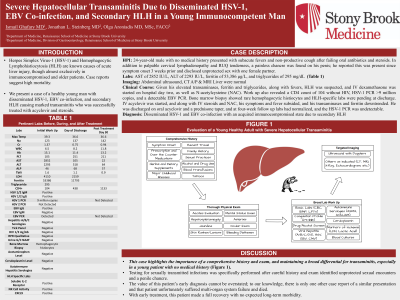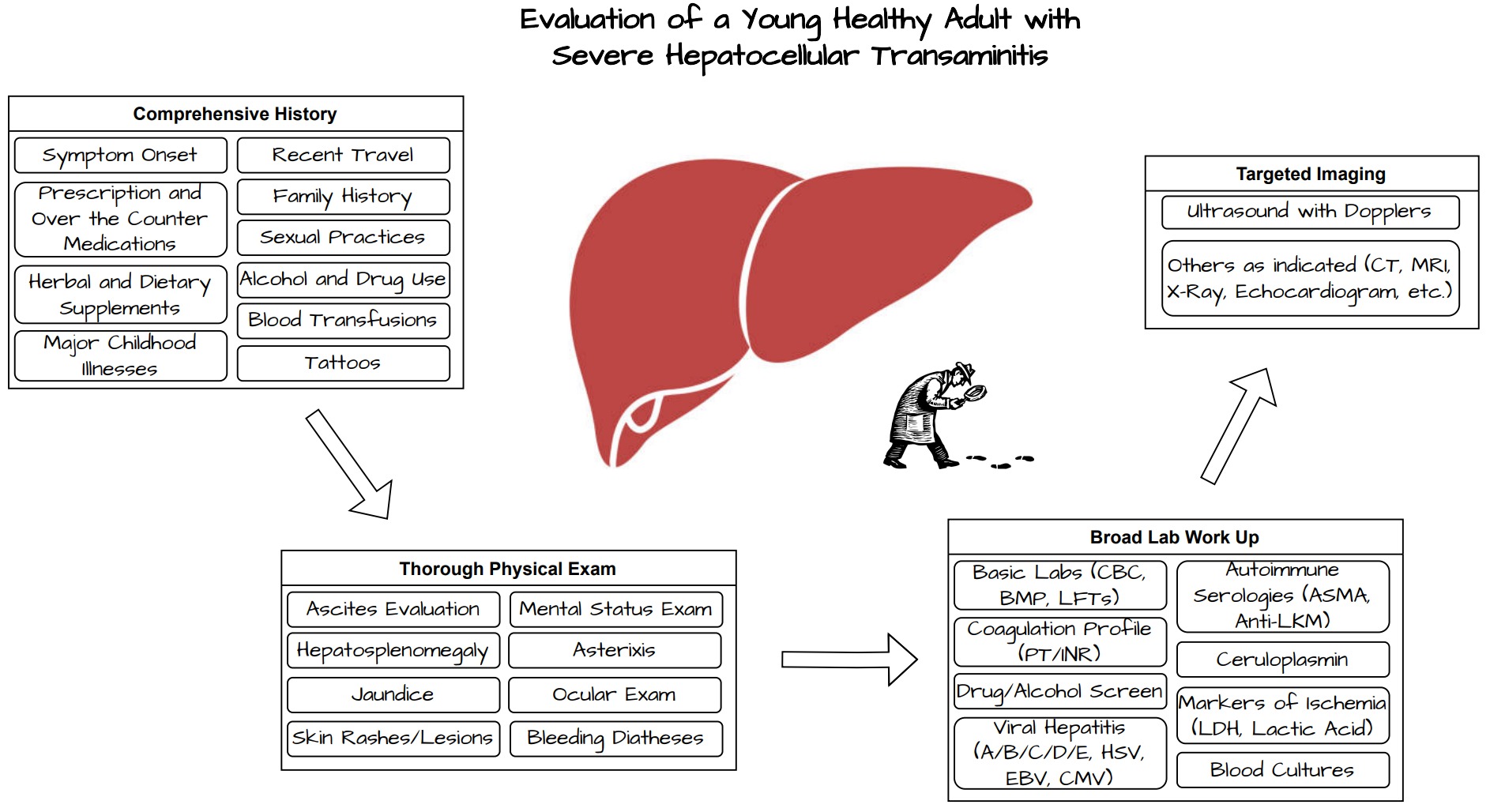Tuesday Poster Session
Category: Liver
P3901 - Severe Hepatocellular Transaminitis Due to Disseminated HSV-1, EBV Co-infection, and Secondary HLH in a Young Immunocompetent Man
Tuesday, October 24, 2023
10:30 AM - 4:00 PM PT
Location: Exhibit Hall

Has Audio

Ismail Ghafary, MD
Stony Brook University Hospital
Stony Brook, NY
Presenting Author(s)
Ismail Ghafary, MD, Jonathan L. Steinberg, MD, Olga Aroniadis, MD, MSc, FACG
Stony Brook University Hospital, Stony Brook, NY
Introduction: Herpes Simplex Virus-1 (HSV-1) and Hemophagocytic Lymphohistiocytosis (HLH) are known causes of acute liver injury, though almost exclusively in immunocompromised patients, and case reports suggest high mortality. We present a case of a healthy young man with disseminated HSV-1, EBV co-infection, and secondary HLH causing marked transaminitis who was successfully treated with acyclovir and steroids.
Case Description/Methods: A 24-year-old man with no medical history presented with subacute fevers and non-productive cough after failing oral antibiotics and steroids. In addition to palpable cervical lymphadenopathy and right upper quadrant tenderness, a painless chancre was found on his penis; he reported this was present since symptom onset, and disclosed unprotected sex with one female partner. Labs were notable for an ALT of 1928 IU/L, ferritin of 53,386µg/L, and triglycerides of 295mg/dL. Abdominal ultrasound was normal and there was no acute liver failure. Given his elevated transaminases, ferritin and triglycerides, along with fevers, HLH was suspected and IV dexamethasone was started on hospital day two, as well as N-acetylcysteine (NAC).
Work up also revealed a CD4 count of 104 without HIV, HSV-1 PCR >9 million copies, and a detectable EBV PCR. Autoimmune and hepatitis A/B/C serologies were negative, MRI liver was normal, and bone marrow biopsy showed rare hemophagocytic histiocytes; HLH-specific labs were pending at discharge. IV acyclovir was started, and along with IV steroids and NAC, his symptoms and fever subsided, and his transaminases and ferritin downtrended. He was discharged on oral acyclovir and a prednisone taper, and at four-week follow up labs had normalized, and the HSV-1 PCR was undetectable. Results of HLH testing confirmed the diagnosis of disseminated HSV-1 and EBV co-infection with an acquired immunocompromised state due to secondary HLH.
Discussion: This case highlights the importance of a comprehensive history and exam, and maintaining a broad differential for transaminitis, especially in a young patient with no medical history. Testing for sexually transmitted infections was specifically performed after careful history and exam identified unprotected sexual encounters and a penile chancre. The value of this patient’s early diagnosis cannot be overstated; to our knowledge, there is only one other case report of a similar presentation and that patient unfortunately suffered multi-organ system failure and died. With early treatment, this patient made a full recovery.

Disclosures:
Ismail Ghafary, MD, Jonathan L. Steinberg, MD, Olga Aroniadis, MD, MSc, FACG. P3901 - Severe Hepatocellular Transaminitis Due to Disseminated HSV-1, EBV Co-infection, and Secondary HLH in a Young Immunocompetent Man, ACG 2023 Annual Scientific Meeting Abstracts. Vancouver, BC, Canada: American College of Gastroenterology.
Stony Brook University Hospital, Stony Brook, NY
Introduction: Herpes Simplex Virus-1 (HSV-1) and Hemophagocytic Lymphohistiocytosis (HLH) are known causes of acute liver injury, though almost exclusively in immunocompromised patients, and case reports suggest high mortality. We present a case of a healthy young man with disseminated HSV-1, EBV co-infection, and secondary HLH causing marked transaminitis who was successfully treated with acyclovir and steroids.
Case Description/Methods: A 24-year-old man with no medical history presented with subacute fevers and non-productive cough after failing oral antibiotics and steroids. In addition to palpable cervical lymphadenopathy and right upper quadrant tenderness, a painless chancre was found on his penis; he reported this was present since symptom onset, and disclosed unprotected sex with one female partner. Labs were notable for an ALT of 1928 IU/L, ferritin of 53,386µg/L, and triglycerides of 295mg/dL. Abdominal ultrasound was normal and there was no acute liver failure. Given his elevated transaminases, ferritin and triglycerides, along with fevers, HLH was suspected and IV dexamethasone was started on hospital day two, as well as N-acetylcysteine (NAC).
Work up also revealed a CD4 count of 104 without HIV, HSV-1 PCR >9 million copies, and a detectable EBV PCR. Autoimmune and hepatitis A/B/C serologies were negative, MRI liver was normal, and bone marrow biopsy showed rare hemophagocytic histiocytes; HLH-specific labs were pending at discharge. IV acyclovir was started, and along with IV steroids and NAC, his symptoms and fever subsided, and his transaminases and ferritin downtrended. He was discharged on oral acyclovir and a prednisone taper, and at four-week follow up labs had normalized, and the HSV-1 PCR was undetectable. Results of HLH testing confirmed the diagnosis of disseminated HSV-1 and EBV co-infection with an acquired immunocompromised state due to secondary HLH.
Discussion: This case highlights the importance of a comprehensive history and exam, and maintaining a broad differential for transaminitis, especially in a young patient with no medical history. Testing for sexually transmitted infections was specifically performed after careful history and exam identified unprotected sexual encounters and a penile chancre. The value of this patient’s early diagnosis cannot be overstated; to our knowledge, there is only one other case report of a similar presentation and that patient unfortunately suffered multi-organ system failure and died. With early treatment, this patient made a full recovery.

Figure: Evaluation of a Young Healthy Adult with Severe Hepatocellular Transaminitis
Disclosures:
Ismail Ghafary indicated no relevant financial relationships.
Jonathan Steinberg indicated no relevant financial relationships.
Olga Aroniadis indicated no relevant financial relationships.
Ismail Ghafary, MD, Jonathan L. Steinberg, MD, Olga Aroniadis, MD, MSc, FACG. P3901 - Severe Hepatocellular Transaminitis Due to Disseminated HSV-1, EBV Co-infection, and Secondary HLH in a Young Immunocompetent Man, ACG 2023 Annual Scientific Meeting Abstracts. Vancouver, BC, Canada: American College of Gastroenterology.
